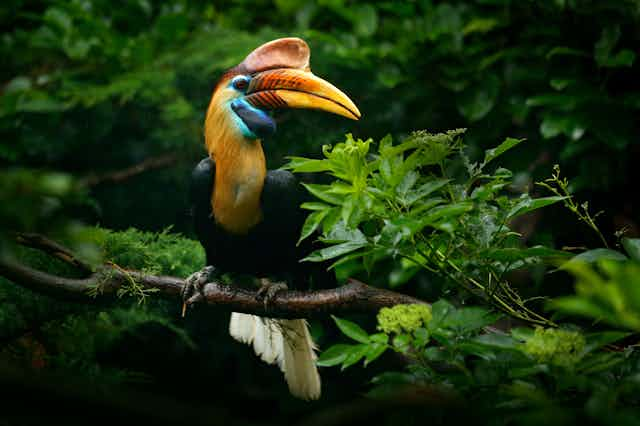Few natural products are as maligned as palm oil, the vegetable oil that’s in everything from chocolate spread to washing up liquid. On the island of Borneo, oil palm plantations have replaced nearly 40% of the native forest cover since 2000. Deforestation releases CO₂ into the atmosphere and deprives rare and endangered species with the complex habitats they need to thrive.
A new study has tried to find out if this valuable crop can be grown without destroying more forests, by converting existing pastureland into new oil palm plantations instead. Could growing more oil palm on land with already scarce wildlife be a solution to the deforestation crisis?
The oil palm tree produces two types of vegetable oil. Palm oil from the fruit is used in cooking and baking and helps feed over three billion people, mostly in Asia. The other oil comes from the palm kernel, or seed, which is used around the world to make most of our detergents, soaps and other cleaning products.

The relentless increase in global demand for vegetable oil has driven the logging and draining of forests and peatland to grow soybeans in South America and oil palm in Asia. About 85% of oil palm is grown in just two countries: Indonesia and Malaysia. But other tropical countries, particularly in South America and West Africa, are establishing their own oil palm plantations. These are vast monocultures that very few species can inhabit, especially compared with the tropical forest they replace.

Use farms not forests
In the recent study, researchers measured how much carbon – previously locked up in trees and other vegetation – was lost to the atmosphere when either pastureland or rainforest was converted to oil palm plantation.
The good news is that turning pastureland into oil palm plantations reduced how much carbon was released by 99.7%, compared to when rainforest was converted. Another bonus of using pastureland might be that its starting biodiversity is relatively low anyway, so the plantation may actually have a greater diversity of wildlife than the previous ecosystem.

Converting grassland ecosystems like the Llanos in South America to oil palm plantations also released less carbon than converting forests. But in this case, the researchers found there were significant losses for biodiversity. If we have to produce more palm oil, the best outcome for wildlife and the climate would be to make former pastureland the first choice for future plantations.
But would it not be better to ban palm oil altogether? Campaigns have urged consumers to switch to products that don’t contain palm oil, while some retailers have announced plans to exclude such items from their own-brand products.
Read more: Replanting oil palm may be driving a second wave of biodiversity loss
Oil palm plantations produce 73.5 million tonnes of vegetable oil from a total land area of 27 million hectares worldwide. This might seem like a large area, but the second most important vegetable oil crop, soybean, produces 56 million tonnes from 97 million hectares – more than 3.6 times the oil palm area. This means that oil palm actually uses much less land than other crops, which is one reason why it’s so popular with growers.

So boycotting palm oil could actually increase deforestation, since alternative tropical oil crops tend to use much more land. A better approach is to ensure that all the palm oil used in food and other products has been obtained from a “sustainable” source, and not from recently logged forests.
That’s why it’s important to base our decisions on sound scientific evidence. Oil palm will continue to be a vital crop for many developing countries in the future. Using former pastureland to grow the crop could ensure the product’s development isn’t at the expense of vulnerable ecosystems. Given how bad red meat production is for the planet, a switch from cattle pasture to oil palm plantation in the tropics could well be a marked improvement.


